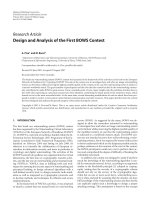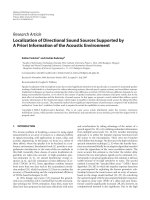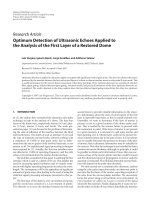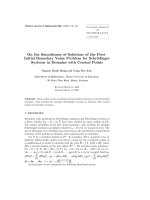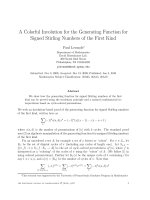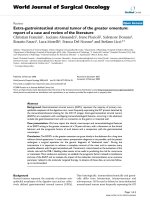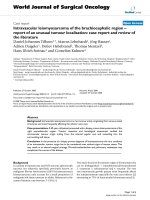Information of the first internship report copy copy
Bạn đang xem bản rút gọn của tài liệu. Xem và tải ngay bản đầy đủ của tài liệu tại đây (61.74 KB, 12 trang )
ĐỖ KIỀU ANH
CLASS: CQ55/21.09
FIRST INTERNSHIP REPORT
TOPIC:
ACCOUNTING FOR SALES, REVENUE AND BUSINESS
RESULTS IN NGOI SAO HOANG GIA INVESTMENT AND
DEVELOPMENT JOINT STOCK COMPANY
MAJOR: BUSINESS ACCOUNTING
INSTRUCTOR: MSC. PHẠM PHƯƠNG ANH
Hanoi-2021
1
CONTENTS
FIRST INTERNSHIP REPORT...............................................................3
DETAILED OUTLINE..............................................................................7
FINANCIAL STATEMENT...................................................................13
2
FIRST INTERNSHIP REPORT
I.
II.
III.
INFORMATION ABOUT MENTOR
PHAM PHUONG ANH MSc
Lecture of Financial Accounting Department
Accounting Faculty – Academy of Finance
Mobile: 0856888187
Email:
INFORMATION ABOUT MENTEE
Name of mentee: Do Kieu Anh
Class: CQ55/21.09
Mobile: 0376.355.299.
Email:
REPORTED CONTENTS:
1. Name and address of internship entity:
Ngoi Sao Hoang Gia Investment and Development Joint Stock Company
2. Name of intended topic:tên đề tài
Accounting for revenue and evaluating results in business
3. Management characteristics of internship entity:
No.
1
2.
3.
Reported Content
Information
Type of business
Joint-stock company
Main business sector
Commercial
Main provided items or
Machinery, equipment and other machine parts
services
4. Organizational characteristics of accounting work at internship entity:
No
1.
Reported Content
Organization model of
accounting apparatus
The accounting regime is
applied
Accounting period
Method of declaring and
paying VAT
Inventory accounting
method
Method of calculating the
cost of issued supplies
Method of calculating the
cost of issued goods
Fixed asset depreciation
method
Accounting software used
Basic accounting tasks at
internship entity (describe
the main work of each
task)
- Cash accounting
2.
3.
4.
5.
6.
7.
8.
9.
10.
Information
Centralized
Circular 133/2016/TT-BTC
A fiscal year
Credit method
Regular declaration method
Weighted-average
Weighted-average
Straight-line method
SIEUVIET
3
- Materials, tools and
supplies accounting
- Fixed assets accounting
- Payroll accounting
- Cost accounting
- Sales and business result
accounting
- Preparing financial
statements
- Other tasks
5. Collected documents:
No.
1
Content
Cash accounting
2
Materials, tools and
supplies accounting
3
Fixed assets accounting
List of vouchers or accounting books collected
Cash accounting
1. Receipts
2. Pay slip
3. Payment national budget
4. Cash inventory sheet
5. Payment demand letter
6. Application for advance
7. Payment for advance letter
8. Payment statement
9. Voucher
Cash in bank accounting
1. Debit advice
2. Credit note
3. Accreditative
4. Payment national budget
1. Stock received docket
2. Delivery slip
3. Invoice value-added input
4. Invoice value-added output
5. Post-entry duty
6. Delivery records
7. Puotation
8. Order
9. Economic contract
10. Record on liquidation of economic contracts
11. Product delivery slip
12. Record on supplies, materials and tools
13. Stock received statement
14. Delivery statement
15. Tement Allocation of materials and tools
1. Delivery records
4
4
5
6
7
8
2.
3.
4.
5.
6.
1.
2.
3.
4.
5.
6.
7.
Record on liquidation of fixed assets
Delivery records of repaired fixed assets
Record on re-evaluation of fixed assets
Record on Fixed assets inventory
Allocation of depreciation of fixed assets.
Payroll accounting
Timesheets
Payroll
The list remitted wages
Payroll and social insurance allocation
Timesheet overtime,
Payment tablev of wage
Labor contract, regulations...
Cost accounting
Sales expenses: Pay table
Fixed asset depreciation expenses: Allocation of
depreciation of fixed assets
Service costs: VAT invoice...
Cost of raw materials, tools: Delivery slip, Allocation of
materials and tools...
Expenses in cash: Pay slip, Debit advice
Sales and business result - Sales accounting
accounting
1. VAT invoice
2. Bill of sale
3. Retail Listings
4. Credit note, Receipts
- Business result accounting
1. Purchase contract
2. VAT invoice
3. Bill of sale
4. Delivered note
5. Record on liquidation of economic contracts
6. Receipts
7. Credit note
8. Pay table of sale of agents and checked goods and
consignment
Preparing financial
1. Subsidiary ledger
statements
2. Cash disbursement/receipt journal
3. General ledger
4. Sales/Purchase journal
5. General journal
6. Balance sheet
7. Financial statement of the previous year
Other tasks
Signature of reporter
5
Anh
Do Kieu Anh
6
DETAILED OUTLINE
CHAPTER I: BASIC ISSUES OF SALES ACCOUNTING AND
DETERMINATION OF SALES RESULTS IN COMMERCIAL
ENTERPRISES
1.1. The necessity to organize sales accounting and determine sales results in
commercial enterprises
1.1.1. Sales and determination of sales results.
1.1.1.1. Concept of sales
1.1.1.2. Concept of determining sales results
1.1.1.3. Relationship between sales and determination of sales results
1.1.2. Management requirements for sales activities and determination of sales
results
1.1.3. Role of sales accounting and determination of sales results in
commercial enterprises
1.1.4. Tasks of sales accounting and determination of sales results in
commercial enterprises
1.2. Sales accounting and determination of sales results in commercial
enterprises
1.2.1. Sales methods and payment methods
1.2.1.1. Sales Method
1.2.1.1.1. Wholesale
1.2.1.1.2. Retail
1.2.1.1.3. Other methods
1.2.1.2. Forms of payment
1.2.1.2.1. Immediate payment
1.2.1.2.2. Post-payment
1.2.1.2.3. Instalments
1.2.2. Accounting of cost of goods sold in commercial enterprises
1.2.2.1. Method of determining the cost of goods sold
1.2.2.2. Documents and accounts used
7
1.2.2.3. Accounting process
1.2.2.3.1. Accounting of cost of goods sold by regular declaration method
1.2.2.3.2. Accounting of cost of goods sold by the method of periodical
inventory
1.2.3. Accounting of sales revenue in commercial enterprises
1.2.3.1. Revenue concept and recording conditions
1.2.3.2. Documents and accounts used
1.2.3.3. Accounting process of some main transactions
1.2.3.3.1. In case the enterprise calculates VAT by tax credit method
1.2.3.3.2. In case the enterprise calculates VAT by direct method
1.2.4. Accounting of revenue deductions
1.2.4.1. Content
1.2.4.2. Documents and accounts used
1.2.4.3. Accounting process of some main transactions
1.2.5. Accounting of sales expenses
1.2.5.1. Content
1.2.5.2. Documents and accounts used
1.2.5.3. Accounting process of some main transactions
1.2.6. Accounting of enterprise management costs
1.2.6.1. Content
1.2.6.2. Documents and accounts used
1.2.6.3. Accounting process of some main transactions
1.2.7. Accounting of business results
1.2.7.1. Content
1.2.7.2. Documents and accounts used
1.2.7.3. Accounting process of some main transactions
1.3. Organizing the sales accounting system and determining business results
in commercial enterprises
1.3.1. General Journal
1.3.1.1. Types of Books
8
1.3.1.2. Advantages and Limitations
1.3.2. Form of Journal – Ledger
1.3.2.1. Types of Books and Book charts
1.3.2.2. Advantages and Limitations
1.3.3. Form of Book-recording documents
1.3.3.1. Book types and Book schemes
1.3.3.2. Advantages and Limitations
1.3.4. Form of Journal – Documents
1.3.4.1. Book types and Book schemes
1.3.4.2. Advantages and Limitations
1.3.5. Organizing sales accounting under conditions of application of
information technology
1.3.5.1. Book recording diagram
1.3.5.2. Advantages and Limitations
1.4. Organizing the presentation of sales information and determining sales
results on financial statements
1.4.1. Indicators and meaning of sales indicators and determination of sales
results on financial statements
1.4.1.1. Indicators of Sales and service provision
1.4.1.2. Indicators of Revenue Deductions
1.4.1.3. Indicators of Net Revenue and Revenue Deductions
1.4.1.4. Indicators of price of goods sold
1.4.1.5. Indicators of Gross Profit for Sales and Service Provision
1.4.1.6. Indicators of Sales expenses
1.4.1.7. Indicators of Enterprise management cost
1.4.2. The manner to set sales indicators and determine sales results on
financial statements
1.4.2.1. Indicators of Sales and service provision
1.4.2.2. Indicators of Revenue Deductions
1.4.2.3. Indicators of Net Revenue and Revenue Deductions
9
1.4.2.4. Indicators of price of goods sold
1.4.2.5. Indicators of Gross Profit for Sales and Service Provision
1.4.2.6. Indicators of Sales expenses
1.4.2.7. Indicators of Enterprise management cost
CHAPTER II: STATUS OF SALES ACCOUNTING AND DETERMINATION
OF BUSINESS RESULTS AT NGOI SAO HOANG GIA INVESTMENT AND
DEVELOPMENT JOINT STOCK COMPANY
2.1. Introduction to Company.
2.1.1. Formation and development of the company
2.1.1.1. Overview introduction of the company
2.1.1.2. History of formation and development of the company
2.1.1.3. Business situation of the company in recent years
2.1.2. Characteristics of the company's business organization
2.1.3. Characteristics of the company's management organization
2.1.3.1. Structure of Management system
2.1.3.2. Functions and tasks of departments
2.1.4. Characteristics of organization of accounting at the Company
2.1.4.1. Organization of the accounting system at the company
2.1.4.2. Accounting policies and regulations applicable at the Company
2.1.4.3. Characteristics of SIEUVIET accounting software used at the company
2.2. Situation of organizing sales accounting and determining sales results at
Company
2.2.1. Accounting of sales revenue and revenue deductions
2.2.1.1. Accounting of sales revenue
2.2.1.1.1. Sales Process of the company
2.2.1.1.2. Sales Methods of the company
2.2.1.1.3. Payment methods of the company
2.2.1.1.4. Sales Policy of the company
2.2.1.1.5. Documents used and procedures for rotation of documents in sales
revenue accounting
10
2.2.1.1.6. Accounts used and accounting process of the main transaction at the
company
2.2.1.1.7. Illustration for sales at the company
2.2.1.1.7.1. Examples of immediate-payment sales
2.2.1.1.7.2. Examples of post-pay sales
2.2.1.2. Accounting of revenue deductions at the company
2.2.1.2.1. Content
2.2.1.2.2. Documents and accounts used
2.2.1.2.3. Accounting order of some main transactions
2.2.2. Accounting of cost of goods sold at the Company
2.2.2.1. Method of determining the cost of goods sold at the company
2.2.2.2. Documents used and procedures for rotation of documents in cost of
goods sold accounting
2.2.2.3. Accounts used and accounting process in accounting of cost of goods
sold
2.2.3. Accounting of sales expenses
2.2.3.1. Contents of sales expenses at the company
2.2.3.2. Documents and accounts used
2.2.3.3. Accounting order of main transactions
2.2.3.4. Illustration for a transaction
2.2.4. Business management costs
2.2.4.1. Contents of enterprise management costs at the company
2.2.4.2. Documents and accounts used
2.2.4.3. Accounting order of main transactions
2.2.4.4. Illustration for a transaction
2.2.5. Accounting of business results at the Company
2.2.5.1. Accounting contents of determining sales results at the company
2.2.5.2. Documents and accounts used
2.2.5.3. Accounting order of main transactions
11
2.2.5.4. Illustration of determining sales results, viewing and exporting types
of books and reports
CHAPTER III: SOLUTIONS TO COMPLETE SALES AND BUSINESS
RESULTS ACCOUNTING AT NGOI SAO HOANG GIA INVESTMENT AND
DEVELOPMENT JOINT STOCK COMPANY
3.1. General assessment on accounting at Company.
3.1.1. Advantages
3.1.2. Limitations
3.2. Assessment s on the organization of sales accounting and determination of
sales results at Company.
3.2.1. Advantages
3.2.2. Limitations
3.3. The solution for improvement of the sales accounting organization and the
business results at Company
3.3.1. The importance of completing sales accounting and determine sales
results
3.3.2. Some recommendations to enhance the sales accounting organization
and determine the sales results at the company
Thank you for reading my report!
12

